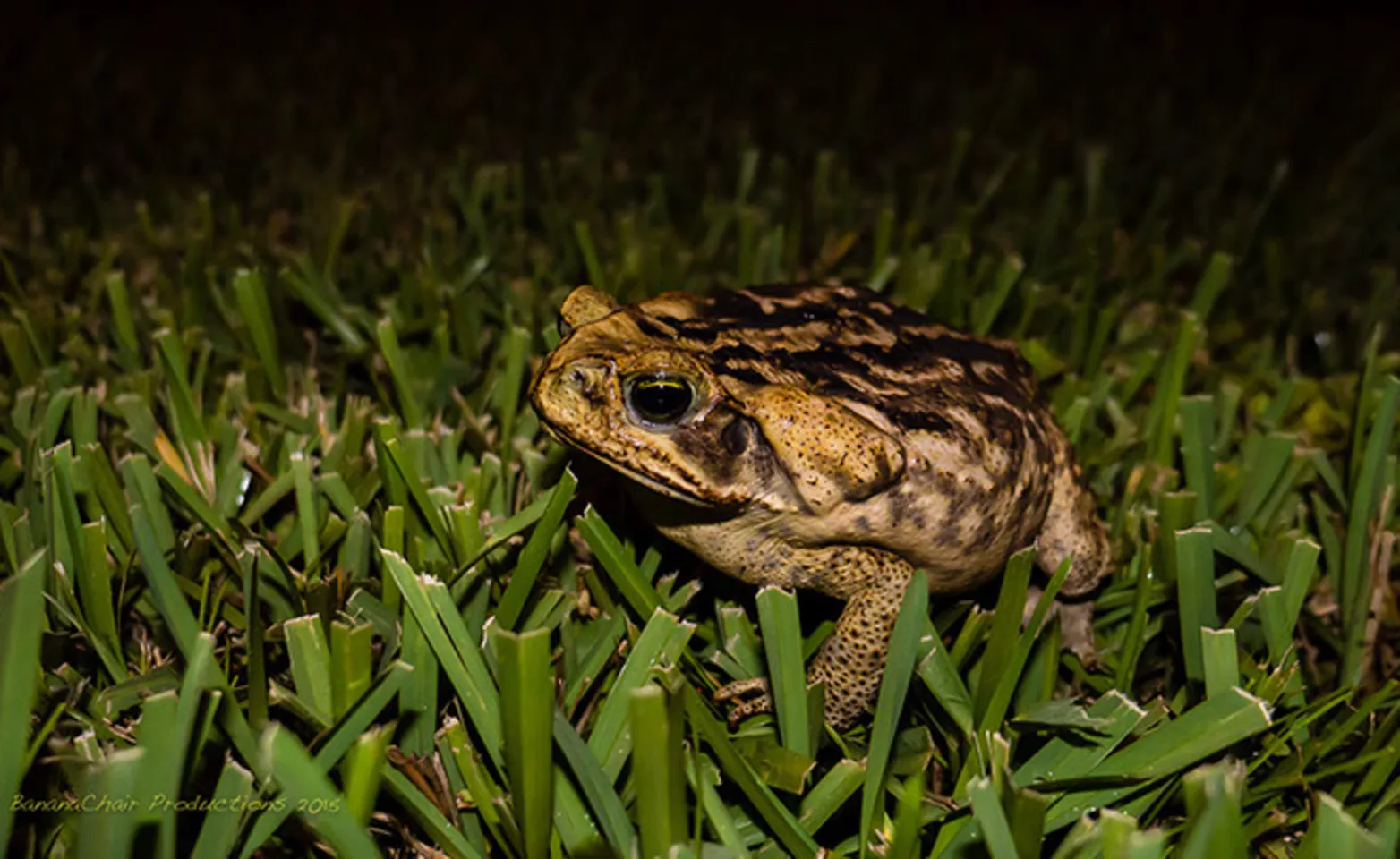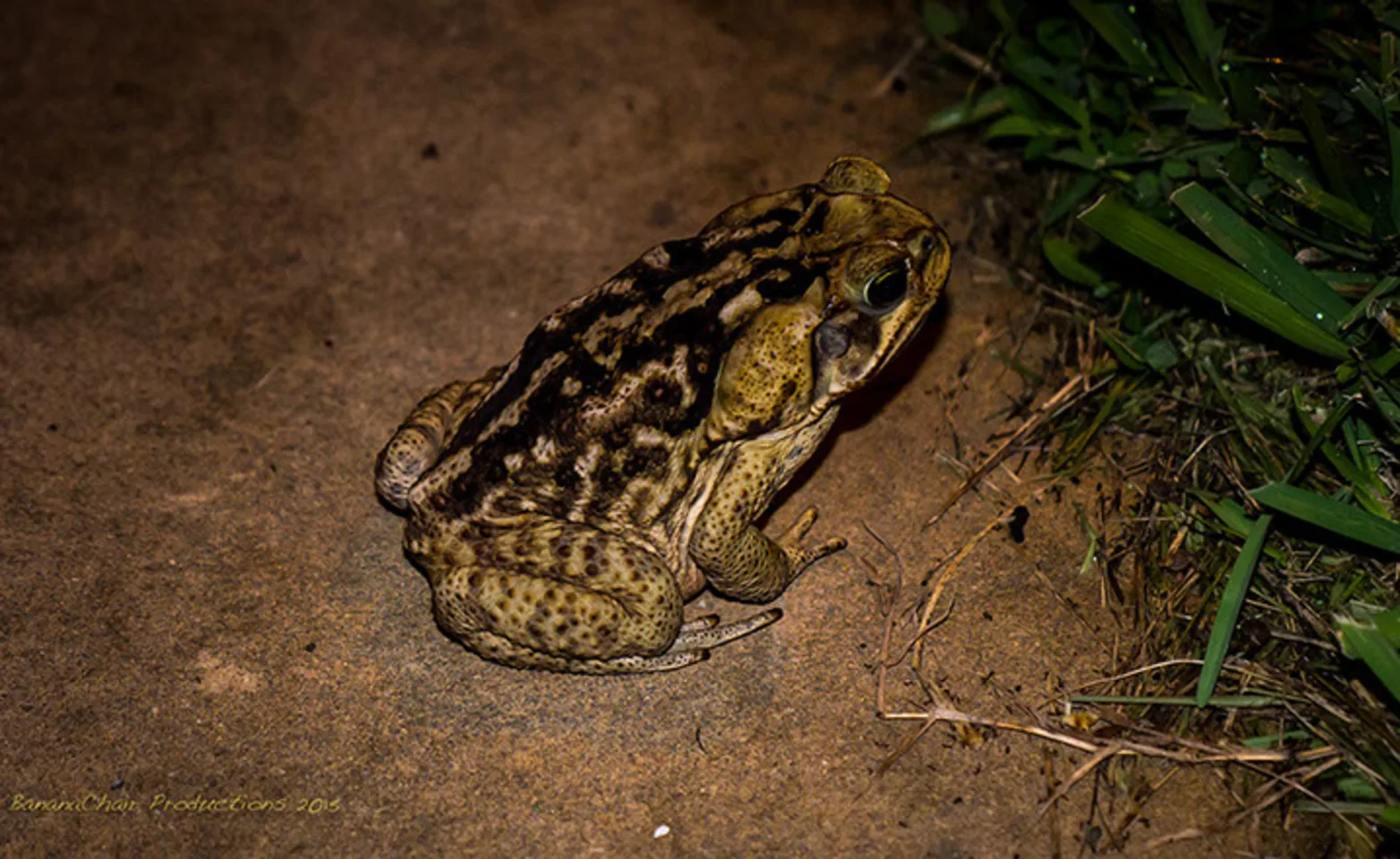Pet Emergency & Referral Center

The Quick Points for First Aid
Neuro and cardio toxic (affecting brain and heart)
Commonly results in seizures, trouble walking, drooling, facial irritation, vomiting, and slow heart rates
Can be life threatening
WIPE gums with wet rag or towel as first aid
Careful if using hose or other running water to not cause aspiration and drowning (this is common)
Seek veterinary care quickly
If your pet is affected, stop reading further and call (561) 691-9999 right away or get to nearest veterinarian right away

Identification
Brown with dark brown spotted pattern
Bumpy, dry skin
Not slimy - although you may see foamy white fluid coming from behind head which is the toxin being secreted
On the ground - these are not to be confused with the native green tree frogs that stick to your window (green tree frogs are not toxic). It should be noted, however, that the Cuban tree frog, which is smaller and more brown in color, is technically toxic but does not cause seizures but may cause mild irritation to the mouth and eyes and possibly vomiting.
Toad may flatten itself into ground to hide - it's amazing how flat they can get!
Toad may also puff up and turn itself sideways to make itself bigger - this will normally be the larger toads
Can make hissing sound when threatened
Range in size from thumb nail to softball/grapefruit size
They like water but are not typically seen swimming - they lay their eggs in water like all amphibians and eggs become tadpoles
Most prominent at night and after heavy rain. Also may be found near bodies of water, such as ponds, lakes, or even just water bowls of outdoor pets.
Most common during summer and fall (the warm and wet months)
Even though they are mainly nocturnal and like it wet and warm, they can be seen any time
They won't give you warts
Bufo Toad Toxicity
Bufo toads (Bufo marinus -commonly known as the cane toad, marine toad, giant toad, or neotropical toad) are toads that are common to South Florida, especially in areas of low lying swampland and near bodies of water. This toad is a non-native species that was introduced to Florida for the purpose of controlling pests such as the white grub in sugar cane fields. These toads secrete a toxin from small glands behind their ears, yes they have ears. When a larger animal, such as a dog, bites down on a bufo toad the toxin that is on the surface of the toad gets into the mouth of the predator animal (in this case a dog). This toxin is rapidly absorbed into the bloodstream via the mucous membranes (gums and tongue) and causes illness or toxicosis. Note that frogs found in Florida are non-toxic and there is an important distinction between frog and toad. Frogs tend to be smooth and slimy while toads are more rough and bumpy in appearance and don’t tend to look as slimy.
What does the toxin do to a dog?
Bufo toad toxins attack two main body systems, the central nervous system, and the cardiovascular system. It commonly causes seizures, ataxia, tachyarrhythmias (fast heart rate) and/or bradyarrhythmias (slow heart rate). Along with harming these two body systems we also see local irritation of the mucous membranes and we see gastrointestinal problems as well such as vomiting and diarrhea. The most common presentation for a dog that just got a hold of a bufo toad is either seizures or ataxia. Ataxia is discoordination, imbalance, and drunkenness. Patients will often stagger or fall over when trying to walk. Seizures caused by bufo toads are often grand mal and usually cause tetany or extensor muscle rigidity. In other words, most dogs with seizures from toads often look stiff. The eyes will often have nystagmus or move back and forth horizontally in a rapid pattern. There will often be excessive drooling from the mouth and a dead giveaway that a dog got into a toad is that their gums will be very red instead of the usual pink.
Does this toxin affect humans?
Yes. It can cause irritation of the skin and eyes if it comes in contact with you in those places. Use water to flush the toxin away for 5-10 minutes. Cool water is best. If irritation persists then seek help from your physician or emergency room.
What do I do if I see my dog get a toad?
The first step is obvious: separate dog and toad right away. Get your dog inside and get a damp towel, or damp clean rag, and use this to wipe the gums. This will physically remove the toxin from the mucous membranes. The author recommends not using running water sources to rinse the mouth out as there have been too many cases of drownings and near-drownings because of this. Once you have wiped the gums get your dog to a veterinarian right away. Many times you will wait a little while in the waiting room simply to be sent home a little while later. However, there are many times that the toxin will start taking effect after a few minutes and you’ll be glad you were already on your way to a vet if seizures or other clinical signs begin.
Treatment
There is no specific treatment for toad toxicity other than wiping the gums free of toxin. Treatment is largely symptomatic and supportive. Seizures and rigidity are treated with either valium, midazolam, or propofol. Most patients will spend at least 12 hours in the hospital until being sent home and this, of course, depends on how well they recover. Many patients will spend some time on oxygen and may also get IV fluids. Oftentimes, anti-vomiting medications are needed due to nausea or vomiting from the toxin. Some patients may require medications to help control cardiac arrhythmias and require ECG monitoring as well.
Prognosis
Prognosis is highly variable and depends on how much toxin was received by the dog, how sensitive the dog is to the toxin, and how long it has been until treatment was initiated. If seizures are intense and last for a long while (>10-15 minutes) secondary complications such as cerebral edema (brain swelling), pulmonary edema (fluid in the lungs), heat stroke, and a condition known as DIC can occur and will greatly effect prognosis in a negative manner. Patients exhibiting both profound neurologic and cardiac signs have a more guarded prognosis. Overall, bufo toad toxicity is a very common emergency problem that is seen on a near nightly basis at this facility and is normally treated with great success. That being said, it can be very serious and life threatening and should be treated accordingly.
Prevention
Dogs who chase bufo toads are often repeat offenders and will usually repeat the process despite if they get sick the first, second, or third time. Certain breeds are over represented as they are breeds that were bred to hunt small game and vermin. Dachshunds and most terrier breeds are usually guilty parties. It is very hard to prevent or eradicate bufo toads. You can consult a pest control service to see what can be done but you’ll likely find that the population is nearly endless. Your best bet is to keep close watch of your dog when outside. Bufo toads are most common at dawn and dusk and after heavy rains. Areas with lights during the night, such as near front doors are very common places because they attract bugs. Bodies of water such as lakes and ponds are also very common places to find heavy toad populations since this is where they breed and lay their eggs.
Summary
Bufo toad toxins cause seizures and cardiac arrhythmias and can be life-threatening.
They are most prevalent at the edge of light and at night especially after it rains.
Wipe the gums after exposure. Do not use a hose.
Dogs that chase and get bufo toads will likely do it again and again.
Prognosis is usually very good but is variable. Can be life-threatening especially if not treated appropriately in a timely manner.
Seek veterinary care immediately.
